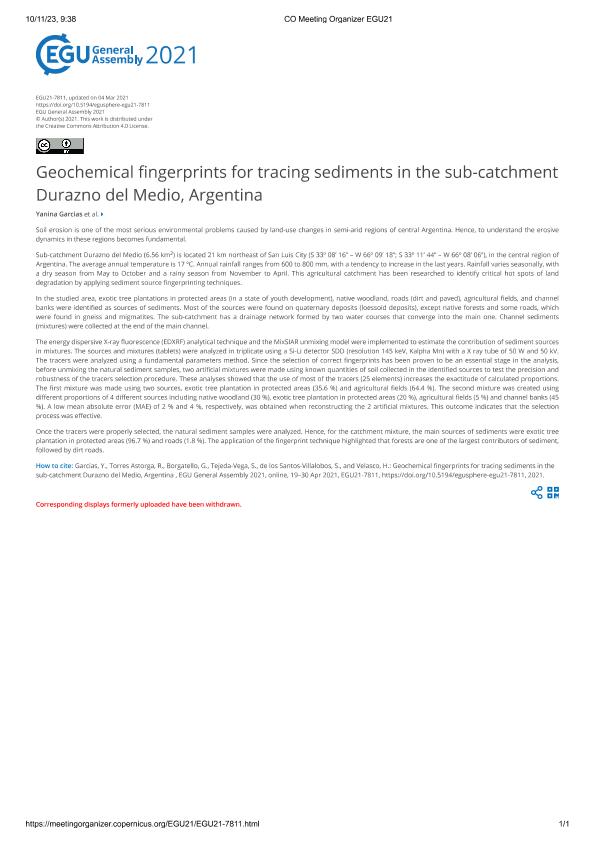Evento
Geochemical fingerprints for tracing sediments in the sub-catchment Durazno del Medio, Argentina
Garcias Paez, Yanina Vanesa ; Torres Astorga, Romina Vanesa
; Torres Astorga, Romina Vanesa ; Borgatello, Gisela Natalia
; Borgatello, Gisela Natalia ; Tejeda, Samuel; de los Santos Villalobos, Sergio; Velasco, Ricardo Hugo
; Tejeda, Samuel; de los Santos Villalobos, Sergio; Velasco, Ricardo Hugo
 ; Torres Astorga, Romina Vanesa
; Torres Astorga, Romina Vanesa ; Borgatello, Gisela Natalia
; Borgatello, Gisela Natalia ; Tejeda, Samuel; de los Santos Villalobos, Sergio; Velasco, Ricardo Hugo
; Tejeda, Samuel; de los Santos Villalobos, Sergio; Velasco, Ricardo Hugo
Tipo del evento:
Conferencia
Nombre del evento:
EGU General Assembly 2021
Fecha del evento:
19/04/2021
Institución Organizadora:
European Geosciences Union;
Título de la revista:
vEGU21: Gather Online
Editorial:
European Geosciences Union
Idioma:
Inglés
Clasificación temática:
Resumen
Soil erosion is one of the most serious environmental problems caused by land-use changes in semi-arid regions of central Argentina. Hence, to understand the erosive dynamics in these regions becomes fundamental. Sub-catchment Durazno del Medio (6.56 km2) is located 21 km northeast of San Luis City (S 33º 08’ 16” – W 66º 09’ 18”; S 33º 11’ 44” – W 66º 08’ 06”), in the central region of Argentina. The average annual temperature is 17 ºC. Annual rainfall ranges from 600 to 800 mm, with a tendency to increase in the last years. Rainfall varies seasonally, with a dry season from May to October and a rainy season from November to April. This agricultural catchment has been researched to identify critical hot spots of land degradation by applying sediment source fingerprinting techniques. In the studied area, exotic tree plantations in protected areas (in a state of youth development), native woodland, roads (dirt and paved), agricultural fields, and channel banks were identified as sources of sediments. Most of the sources were found on quaternary deposits (loessoid deposits), except native forests and some roads, which were found in gneiss and migmatites. The sub-catchment has a drainage network formed by two water courses that converge into the main one. Channel sediments (mixtures) were collected at the end of the main channel. The energy dispersive X-ray fluorescence (EDXRF) analytical technique and the MixSIAR unmixing model were implemented to estimate the contribution of sediment sources in mixtures. The sources and mixtures (tablets) were analyzed in triplicate using a Si-Li detector SDD (resolution 145 keV, Kalpha Mn) with a X ray tube of 50 W and 50 kV. The tracers were analyzed using a fundamental parameters method. Since the selection of correct fingerprints has been proven to be an essential stage in the analysis, before unmixing the natural sediment samples, two artificial mixtures were made using known quantities of soil collected in the identified sources to test the precision and robustness of the tracers selection procedure. These analyses showed that the use of most of the tracers (25 elements) increases the exactitude of calculated proportions. The first mixture was made using two sources, exotic tree plantation in protected areas (35.6 %) and agricultural fields (64.4 %). The second mixture was created using different proportions of 4 different sources including native woodland (30 %), exotic tree plantation in protected areas (20 %), agricultural fields (5 %) and channel banks (45 %). A low mean absolute error (MAE) of 2 % and 4 %, respectively, was obtained when reconstructing the 2 artificial mixtures. This outcome indicates that the selection process was effective. Once the tracers were properly selected, the natural sediment samples were analyzed. Hence, for the catchment mixture, the main sources of sediments were exotic tree plantation in protected areas (96.7 %) and roads (1.8 %). The application of the fingerprint technique highlighted that forests are one of the largest contributors of sediment, followed by dirt roads.
Palabras clave:
erosion
,
fingerprints
,
geochemical
,
tracing
Archivos asociados
Licencia
Identificadores
Colecciones
Eventos(IMASL)
Eventos de INST. DE MATEMATICA APLICADA DE SAN LUIS
Eventos de INST. DE MATEMATICA APLICADA DE SAN LUIS
Citación
Geochemical fingerprints for tracing sediments in the sub-catchment Durazno del Medio, Argentina; EGU General Assembly 2021; Viena; Austria; 2021; 1-2
Compartir
Altmétricas



